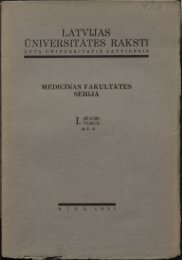ornamental sign language in the first order tracery belts - DSpace
ornamental sign language in the first order tracery belts - DSpace
ornamental sign language in the first order tracery belts - DSpace
You also want an ePaper? Increase the reach of your titles
YUMPU automatically turns print PDFs into web optimized ePapers that Google loves.
Tenisons, M; Zeps, D. Ornamental Sign Language In The First Order Tracery Belts<br />
estimation, not <strong>in</strong> reach of exact scientific criteria. All this shows necessity to do researches<br />
and typology of <strong>ornamental</strong> patterns <strong>in</strong> gradual way, from simpler to more complex.<br />
Mak<strong>in</strong>g research <strong>in</strong> field as complex as of Lielvārdes belt researchers face question: is this<br />
only problem of artists or, say, researches of <strong>the</strong> Liv<strong>in</strong>g Ethics? Many speak about<br />
<strong>in</strong>formation from <strong>the</strong> Cosmos. What is this? Are <strong>the</strong>se th<strong>in</strong>gs subject to research or only area<br />
of religion or mystics? Exact sciences tend to say that <strong>the</strong>y do not want to have anyth<strong>in</strong>g<br />
shared with <strong>the</strong> Liv<strong>in</strong>g Ethics? But <strong>the</strong>y may have common area of <strong>in</strong>vestigations, scilicet,<br />
belt of Lielvārde. Now, when question may has become even more complex we may have for<br />
this a new justification: we may ask – <strong>the</strong> Cosmos provides us with visual or <strong>in</strong>strumental<br />
<strong>in</strong>formation? See [11].<br />
Does <strong>the</strong>re exist <strong>first</strong> <strong>order</strong> complexity <strong>in</strong> <strong>the</strong> nature?<br />
The research of <strong>belts</strong> is not only recreative enterta<strong>in</strong>ment that doesn’t have anyth<strong>in</strong>g <strong>in</strong><br />
connection with research <strong>in</strong> nature or ma<strong>the</strong>matics. Question about what is primary – code or<br />
image – might be more actual than we assume, and not only <strong>in</strong> <strong>ornamental</strong>istic but <strong>in</strong> nature<br />
too.<br />
Ornamentalistic might play important role <strong>in</strong> different areas of science, arts, where <strong>the</strong>se<br />
areas may <strong>in</strong>tertw<strong>in</strong>e. We may use <strong>language</strong> of artists and try to unite with precise <strong>language</strong><br />
of ma<strong>the</strong>matics similarly as we tried to do <strong>in</strong> this article. Ornamentalistic would be <strong>the</strong><br />
branch where without this syn<strong>the</strong>sis were hard to get along. But here may come o<strong>the</strong>r areas<br />
<strong>in</strong>to touch too, say, physics, biology, psychology. The last is mentioned <strong>in</strong> very <strong>in</strong>terest<strong>in</strong>g<br />
aspect <strong>in</strong> <strong>the</strong> movie „The belt of Lielvārde. On hypo<strong>the</strong>sis of Tõnis V<strong>in</strong>t”. Let us take look<br />
<strong>in</strong>to <strong>the</strong> message of Tõnis V<strong>in</strong>t (Estonia) (transl. by D.Z.):<br />
„Through times and lands <strong>sign</strong>s unite us and narrate. For example, <strong>the</strong>se<br />
Mexican temple walls hide about <strong>the</strong> world three layers of <strong>in</strong>formation:<br />
everyday objective, facts about events, and phenomena <strong>in</strong> nature<br />
description. Gifted for this last epistemology were only some chosen<br />
people. Several notions for a s<strong>in</strong>gle symbol were present also <strong>in</strong> Ch<strong>in</strong>ese<br />
tables of I-C<strong>in</strong> : heaven – virility, earth – fem<strong>in</strong><strong>in</strong>ity, and parallel notions:<br />
heaven – creation fa<strong>the</strong>r, earth – submission mo<strong>the</strong>r, water, moon, danger,<br />
fire, light, sun, and o<strong>the</strong>r mean<strong>in</strong>gs.<br />
To sun, moon, fire and water our ancients attributed magical <strong>sign</strong>ification.<br />
In this way geometric ornaments already long ago were used for practical<br />
reasons.<br />
American Indians lived <strong>in</strong> precisely created circles, that afterwards were<br />
called medical circles, because, how archeological excavations <strong>in</strong>dicated, <strong>in</strong><br />
<strong>the</strong>se settlements liv<strong>in</strong>g Indians of Siu tribe didn’t know illnesses.<br />
Accord<strong>in</strong>g a legend, each child for this tribe had a sage, or a philosophical<br />
fa<strong>the</strong>r specially chosen. Tak<strong>in</strong>g away a child <strong>in</strong>to <strong>the</strong> wild nature, hav<strong>in</strong>g<br />
explored his character and biophysical features, Indian sage draw<br />
15


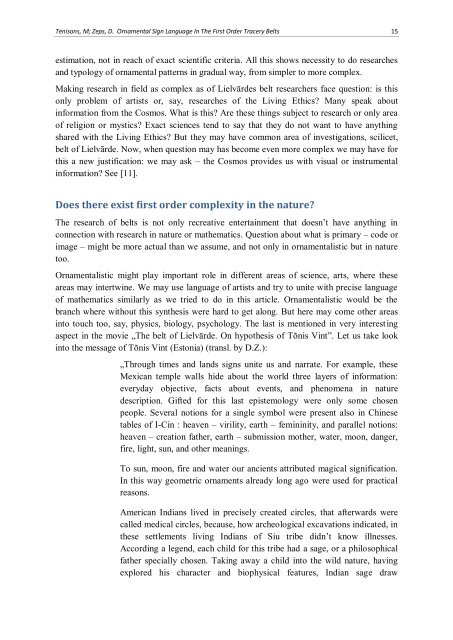

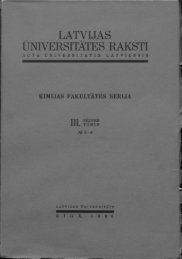
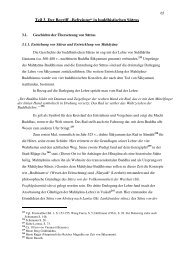
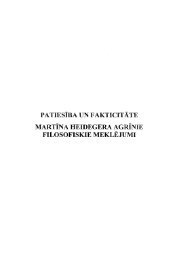
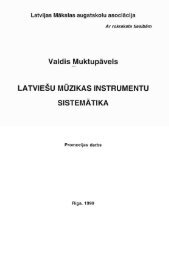
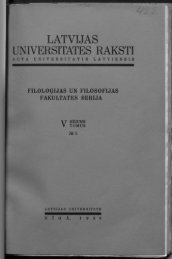
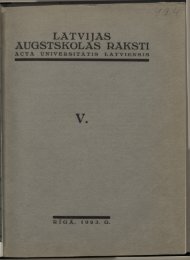


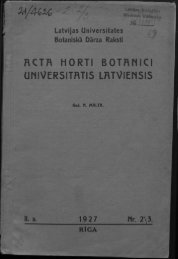
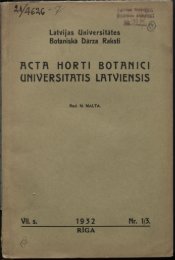
![LATVIJAS] - DSpace](https://img.yumpu.com/11778577/1/190x249/latvijas-dspace.jpg?quality=85)
